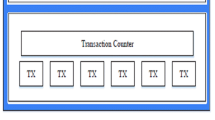Abstract
The most significant issue in the government registry department is the duplicate registry of land in the current scenario. These kinds of problems are increasing day by day by day, which necessitates the advancement of the existing registry process system. It is a manual process that a typical stamp-based or newly not secure online process (only a few places). Use of a manual process, there are many issues in the duplicate registry of a particular land. The final registry, where the landlord has a stamp paper copy and sale deed or a specific number of the property. One receipt copy at the land registry department for their record. Blockchain has emerged as a new technology to resolve or handle the above-said issue of the current system, a distributed ledger that is a timestamp and immutable. Being immutable, forgeries related to the particular land during the registry are not allowed. This concept provides trust and consensus among all entities in the network or system. In this paper, we propose a framework for automated maintains a record of registry papers. This framework will also resolve the most effort to loan clearance operations and provide transparency in government e-governance. The system handled by the blockchain network, instead of existing typical manual processor online registry record maintain the process, it includes: An authentication scheme at multiple levels to make the blockchain-based framework secure, a quick verification for all the stack holders (bank, registry department, buyer, and seller), and apply Smart Contract to automate check the loan process as government norms and facilitate buyer and seller selling and purchase. The obtained consequences are examined against the latest approaches to indicate the supremacy of the proposed framework and provide transparent, accountable, incoherent data with the different government departments.





Similar content being viewed by others
Availability of Data and Material
Data sharing not applicable to this article as no datasets were generated or analyzed during the current study.
Code Availability
Code for blockchain implementation are available on request due to privacy or other restrictions.
References
“3 held for creating fake property documents,” The Hindu, 06-Jan-2021.
FPJ Bureau, “Four held for making fake registry of plot,” Free Press, Indore, 14-Apr-2016.
Chugh, G. (2018). Examining E-governance: A study of land records management system in India. Madhya Pradesh Journal of Social Sciences, 23(2), 33–44.
Saxena, N. (2005). Updating land records: Is computerisation sufficient? Economic and Political Weekly, 40(4), 313–321.
Pandey, P., & Litoriya, R. (2020). Securing E-health networks from counterfeit medicine penetration using Blockchain. Wireless Personal Communications, 117, 7–25.
Prateek, P., & Ratnesh, L. (2020). Promoting trustless computation through blockchain technology. National Academy Science Letters, 44, 225–231.
Akram, S. V., Malik, P. K., Singh, R., Anita, G., & Tanwar, S. (2020). Adoption of blockchain technology in various realms: Opportunities and challenges. Security and Privacy, 3(5), e109.
Prateek, P., & Ratnesh, L. (2020). Securing and authenticating healthcare records through blockchain technology. Cryptologia, 44(4), 341–356.
Nakamoto, S. (2008). Bitcoin: A Peer-to-Peer Electronic Cash System (pp. 1–9).
Pandey, M., Litoriya, R., & Pandey, P. (2019). Identifying causal relationships in mobile app issues: An interval type-2 fuzzy DEMATEL approach. Wireless Personal Communications, 108, 683–710.
Pandey, M., Litoriya, R., & Pandey, P. (2019). Novel approach for mobile based app development incorporating MAAF. Wireless Personal Communications, 107(4), 1687–1708.
Bhattacharya, P., Tanwar, S., Shah, R., and Ladha, A. (2020) Mobile edge computing-enabled blockchain framework—a survey. pp. 797–809.
Esmaeilzadeh, P., & Mirzaei, T. (2019). The potential of blockchain technology for health information exchange: Experimental study from patients’ perspectives. Journal of Medical Internet Research, 21(6), e14184.
Schwartz, D., Youngs, N., & Britto, A. (2014). The ripple protocol consensus algorithm. Ripple Labs Inc White Paper, 5, 151.
Bagga, R. K., & Gupta, P. (2009). Transforming government: e-Governance initiatives in India. Icfai Books.
Aundhe M, D., and Narasimhan, R., (2013) Case Study - NEMMADI, Karnataka.
“UP Bhulekh Khasra Khatauni Naksha 2021,” 2016. [Online]. Available: https://www.mykisan.net/post/bhulekh.
Chauhan, R., (2009) National E-Governance Plan in India.
Sravani, C., & Murali, G. (2019). Usage of blockchain-based provenance enabled technology to process and track land transactions. International Journal of Research in Advent Technology, 1(1), 21–25.
Turakhiya, S. P., & Parekh, C. D. (2019). Research paper on land registry maintenance system using block chaining technology. International Journal for Research in Applied Science & Engineering Technology, 7(5), 1853–1859.
Sekhari, A., Chatterjee, R., Dwivedi, R., Negi, R., & Shukla, S, K., (2019) Entangled Blockchains in Land Registry Management. In: Proceedings of the third workshop on blockchain technologies and its applications, pp. 8–13.
Sahai, A and Pandey, R., (2020) Smart contract definition for land registry in blockchain. In: 2020 IEEE 9th International conference on communication systems and network technologies (CSNT), pp. 230–235.
Rouhani, S., & Deters, R. (2019). Security, performance, and applications of smart contracts: A systematic survey. IEEE Access, 7, 50759–50779.
Gopie, N “What are smart contracts on blockchain?,” IBM, 2018. [Online]. Available: https://www.ibm.com/blogs/blockchain/2018/07/what-are-smart-contracts-on-blockchain/. [Accessed: 22-May-2020].
Thakur, V., Doja, M. N., Dwivedi, Y. K., Ahmad, T., & Khadanga, G. (2020). Land records on blockchain for implementation of land titling in India. International Journal of Information Management, 52, 101940.
Funding
None.
Author information
Authors and Affiliations
Contributions
SS, RL and PP contributed to the design and implementation of the research, to the analysis of the results and to the writing of the manuscript. All authors discussed the results and commented on the manuscript.
Corresponding author
Ethics declarations
Conflict of interest
The authors declare that there is no conflict of interest.
Additional information
Publisher's Note
Springer Nature remains neutral with regard to jurisdictional claims in published maps and institutional affiliations.
Rights and permissions
About this article
Cite this article
Soner, S., Litoriya, R. & Pandey, P. Exploring Blockchain and Smart Contract Technology for Reliable and Secure Land Registration and Record Management. Wireless Pers Commun 121, 2495–2509 (2021). https://doi.org/10.1007/s11277-021-08833-1
Accepted:
Published:
Issue Date:
DOI: https://doi.org/10.1007/s11277-021-08833-1




